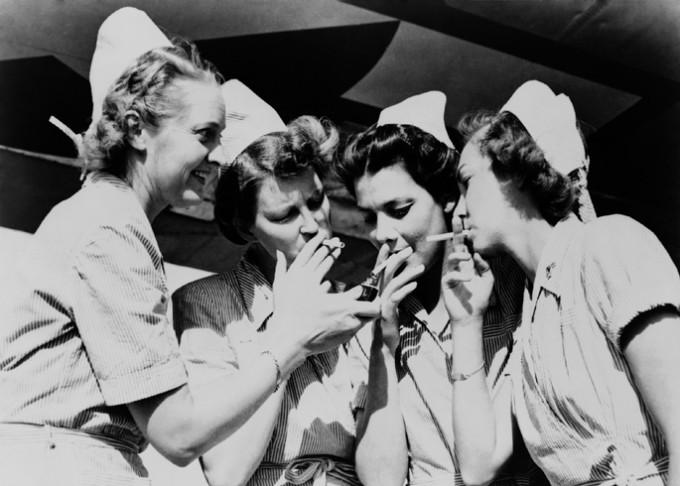Feature
When Nurses Smoked in Hospitals
In years past, there was an ashtray on every patient nightstand, nurses lit up in break rooms, and doctors and nurses were featured in cigarette ads

An attractive young woman in a crisp, white vintage nurse’s uniform and cap smiles up at the reader, dangling a lit cigarette between her fingers. Printed above her is a boldface slogan: “You like them FRESH? So do I!”
Although the copy for this 1932 print ad for Camel cigarettes doesn’t identify the model as an actual nurse, it would have been no surprise if she were. Once upon a time, many nurses, doctors and patients smoked, even inside hospitals.
Today, it’s hard to believe this was a fact and not just an urban myth. Years ago, smoking was glamorous and socially acceptable. Cigarettes were not generally viewed as harmful, addictive public health menaces, but as pleasurable indulgences enjoyed by most American adults.
Today, tobacco smoking is known to be addictive and a leading cause of cancer and respiratory diseases. As more hospitals, schools and businesses become “smoke-free” environments, smoking is rarely tolerated. In fact, new nurses who are smokers may find themselves to be unemployable.
“Those Were Different Times!”
On the Facebook page of the nursing group Show Me Your Stethoscope (SMYS), veteran nurses recently shared some of their past experiences with smoking in hospitals. Typical comments declared, “Those were different times! It was a different world. Everyone smoked.”
From the late 1800s until the early 1990s, tobacco was a routine part of the American hospital landscape. Doctors might smoke cigars or pipes while delivering a diagnosis or even while in the operating room. (One SMYS commenter recalls once being written up for refusing to fetch an ashtray for a doctor.)
Nurses routinely smoked in the nurse’s station, during report, while organizing their med carts and sometimes with their patients. Some hospitals had designated smoking lounges next to patient rooms. A compassionate nurse might hold up a cigarette to a dying patient’s tracheotomy tube so that they could take their last puff. Hospitals sometimes sold their patients cigarettes, which were taken into patient rooms on carts, along with chewing gum, toiletries and books. Charge nurses’ offices stocked plenty of ashtrays, often bearing the hospital logo.
Dan Carnithan, a respiratory therapist, says, “In the 1970s, there was an ashtray on every patient’s nightstand. The gift shop sold cigarettes with matches. … Sounds bizarre now, but that was the way it was back then!”
As late as the mid-80s, Jan Potter, RN, a former smoker, says that in state psychiatric hospitals, “the patients were allowed to smoke in the common areas — in fact, we provided ‘state tobacco’ for those that did not have money to buy their own. We even rolled cigarettes with one of those little machines for those who couldn’t roll their own.”
What About the Nurses?
Despite an official ban on staff smoking in common areas, Potter says, “We did it anyway during the swing shift. …. Patients knew which staff regularly only partially smoked a cigarette and would gather around that person and ask for ‘shorts’ …. Makes me cringe now.”
Lois Albrecht-Anderson, RN, says some hospital departments used tobacco therapeutically. “On the rehab floor, every morning, the ‘quads’ would get a cup of coffee, a cigarette and then get put on the toilet,” she explains, “Quick and easy laxative!”
Smoking in hospitals was shockingly common even in situations where it directly put patients at risk. Donna Schultz, RN, says that a patient room in the respiratory ICU where she worked in the early ‘80s doubled as the staff break room and smoking lounge.
“Every 12-hour shift change, we would sit in that room and smoke during report,” Schultz recalls. “When we would open the door, a cloud of smoke would blow out into the unit. Even the nonsmokers stank. Most of our patients had trachs, were on vents or had lung cancer or COPD from smoking.”












